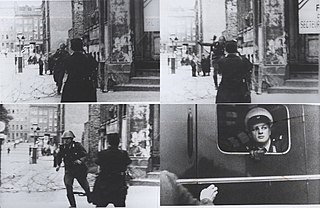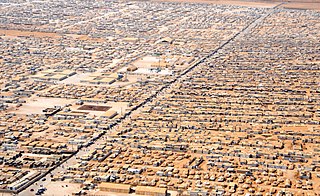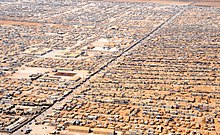The Office of the United Nations High Commissioner for Refugees (UNHCR) is a United Nations agency mandated to aid and protect refugees, forcibly displaced communities, and stateless people, and to assist in their voluntary repatriation, local integration or resettlement to a third country. It is headquartered in Geneva, Switzerland, and has 20,305 staff working in 136 countries as of December 2023.

A refugee, according to the United Nations High Commissioner for Refugees (UNHCR), is a person "forced to flee their own country and seek safety in another country. They are unable to return to their own country because of feared persecution as a result of who they are, what they believe in or say, or because of armed conflict, violence or serious public disorder." Such a person may be called an asylum seeker until granted refugee status by a contracting state or by the UNHCR if they formally make a claim for asylum.
Palestinian refugees are citizens of Mandatory Palestine, and their descendants, who fled or were expelled from their country, village or house over the course of the 1948 Palestine war and during the 1967 Six-Day War. Most Palestinian refugees live in or near 68 Palestinian refugee camps across Jordan, Lebanon, Syria, the West Bank and the Gaza Strip. In 2019 more than 5.6 million Palestinian refugees were registered with the United Nations.
Camps were set up by the United Nations Relief and Works Agency (UNRWA) in Jordan, Lebanon, Syria, the West Bank and the Gaza Strip to accommodate Palestinian refugees registered with UNRWA, who fled or were expelled during the 1948 Palestinian expulsion and flight after the 1948 Arab–Israeli War or in the aftermath of the Six-Day War in 1967, and their patrilineal descendants. There are 68 Palestinian refugee camps, 58 official and 10 unofficial, ten of which were established after the Six-Day War while the others were established in 1948 to 1950s.

A refugee camp is a temporary settlement built to receive refugees and people in refugee-like situations. Refugee camps usually accommodate displaced people who have fled their home country, but camps are also made for internally displaced people. Usually, refugees seek asylum after they have escaped war in their home countries, but some camps also house environmental and economic migrants. Camps with over a hundred thousand people are common, but as of 2012, the average-sized camp housed around 11,400. They are usually built and run by a government, the United Nations, international organizations, or non-governmental organization. Unofficial refugee camps, such as Idomeni in Greece or the Calais jungle in France, are where refugees are largely left without the support of governments or international organizations.

Jordan–Syria relations are bilateral relations between the sovereign states of Jordan and Syria. Relations between neighbours have ancient roots as both countries are historically parts of the Levant or the region of Syria. The two states were created after the First World War from former Ottoman dominions by way of a secret bilateral agreement between Britain and France.

Throughout the 20th century, Iraq witnessed multiple periods of instability and conflict that prompted the creation and flight of many refugees. Earlier examples include the exodus of Iraqi Jews and the flight of Iraqi Kurds. The Iraqi invasion of Iran in 1980 and the ensuing Iran–Iraq War (1980–1988) triggered a deterioration of ties among the country's various ethnic and religious communities, and also exacerbated in violent events like the Ba'athist Arabization campaigns in northern Iraq (1968–2003), which led to the killing and displacement of thousands of minorities. The Iraqi invasion of Kuwait (1990) and the ensuing Gulf War (1990–1991), which ended with Iraq's defeat and the application of United Nations sanctions (1991–2003), also resulted in the creation of many Iraqi refugees. It was not until the beginning of the ongoing Iraqi conflict, however, that sustained waves of Iraqi refugees would be created, numbering in the millions: the 2003 invasion of Iraq and the ensuing Iraq War (2003–2011) killed and displaced hundreds of thousands of Iraqis, both internally and externally, and the later War in Iraq (2003–2017) forced even more people to flee from the country. Many Iraqi refugees established themselves in urban areas of other countries rather than in refugee camps.

Palestinians in Iraq are people of Palestinians, most of whom have been residing in Iraq after they were displaced in 1948. Before 2003, there were approximately 34,000 Palestinians thought to be living in Iraq, mainly concentrated in Baghdad. However, since the 2003 Iraq War, the figure lies between 10,000–13,000, although a precise figure has been hard to determine. The situation of Palestinians in Iraq deteriorated after the fall of Saddam Hussein and particularly following the bombing of the Al-Askari Mosque in 2006. Since then, with the rise in insecurity throughout Iraq, they have been the target of expulsion, persecution and violence by Shia militants, and the new Iraqi Government with militant groups targeting them for preferential treatment they received under the Ba'ath Party rule. Currently, several hundred Palestinians from Iraq are living in border camps, after being refused entry to neighbouring Jordan and Syria. Others have been resettled to third countries.
Refugees of the Syrian civil war are citizens and permanent residents of Syria who have fled the country in the course of the Syrian civil war. The pre-war population of the Syrian Arab Republic was estimated at 22 million (2017), including permanent residents. Of that number, the United Nations (UN) identified 13.5 million (2016) as displaced persons in need of humanitarian assistance. Since the start of the Syrian civil war in 2011 more than six million (2016) were internally displaced, and around five million (2016) crossed into other countries, seeking asylum or placement in Syrian refugee camps. It is believed to be one of the world's largest refugee crises.
Qatar Charity is a humanitarian and development non-governmental organization in the Middle East. It was founded in 1992 in response to the thousands of children who were made orphans by the Afghanistan war and while orphans still remain a priority cause in the organization's work with more than 150,000 sponsored orphans, it has now expanded its fields of action to include six humanitarian fields and seven development fields.

The Zaatari refugee camp is a refugee camp in Jordan, located 10 kilometres (6.2 mi) east of Mafraq, which has gradually evolved into a permanent settlement; it is the world's largest camp for Syrian refugees. It was first opened on 28 July 2012 to host Syrians fleeing the violence in the ongoing Syrian War that erupted in March 2011. It is connected to the road network by a short road which leads to Highway 10.
Refugees in Jordan rose with the uprising against the Syrian government and its President Bashar al-Assad. Close to 13,000 Syrians per day began pouring into Jordan to reside in its refugee camps.

Palestinians in Syria are people of Palestinian origin, most of whom have been residing in Syria after they were displaced from their homeland during the 1948 Palestinian expulsion and flight. Palestinians hold most of the same rights as the Syrian population, but cannot become Syrian nationals except in rare cases. In 2011, there were 526,744 registered Palestinian refugees in Syria. Due to the Syrian Civil War, the number of registered refugees has since dropped to about 450,000 due to many Palestinians fleeing to Lebanon, Jordan or elsewhere in the region to escaping to Europe as refugees, especially to Germany and Sweden.
Syrians in Lebanon refers to the Syrian migrant workers and, more recently, to the Syrian refugees who fled to Lebanon during the Syrian Civil War. The relationship between Lebanon and Syria includes Maronite-requested aid during Lebanon's Civil War which led to a 29-year occupation of Lebanon by Syria ending in 2005. Following the outbreak of the Syrian Civil War, refugees began entering Lebanon in 2011.
A refugee crisis can refer to difficulties and dangerous situations in the reception of large groups of forcibly displaced persons. These could be either internally displaced, refugees, asylum seekers or any other huge groups of migrants.
The Azraq refugee camp is a refugee camp, located near Azraq, Jordan, built for refugees of the Syrian Civil War. It was developed, and is operated, by the United Nations High Commissioner for Refugees (UNHCR) in conjunction with the Government of Jordan. It first opened in April 2014. As of March 2016 it had over 32,000 refugees in it; by August 2019 that number was over 35,000.
Internally displaced persons in Syria are more than half the people fleeing the Syrian Civil War moved only within Syria itself. The United Nations High Commissioner for Refugees (UNHCR) estimates that 7 million persons in Syria are internally displaced or in need of humanitarian assistance, as of 2017. Most live in houses, often badly damaged by the war. Due to security concerns, poor access to areas of need and unpredictability, humanitarian efforts were directed at emergency aid. The complexity of administrative procedures and limited capacity of NGOs permitted to operate in Syria are also cited as challenges to assistance.

Since the onset of the Syrian Civil War in March 2011, over 1.5 million Syrian refugees have fled to Lebanon, and constitute nearly one-fourth of the Lebanese population today. Lebanon currently holds the largest refugee population per capita in the world.

The Saudi Fund for Development (SFD) (Arabic: الصندوق السعودي للتنمية) is a Saudi Arabian government agency that provides assistance to developing countries by financing social and infrastructure projects. The funds development programme seeks to support the economies of recipient countries by enhancing economic growth and promoting job opportunities. The SFD was established in 1974 and began operations in 1975. The SFD established government agency has continued to expand through development, finance, trade, and funding. Today, it is involved in 3750 projects in 71 countries. The fund is led by Ahmed bin Aqeel Al-Khateeb, who also serves as the Minister of Tourism for Saudi Arabia.















